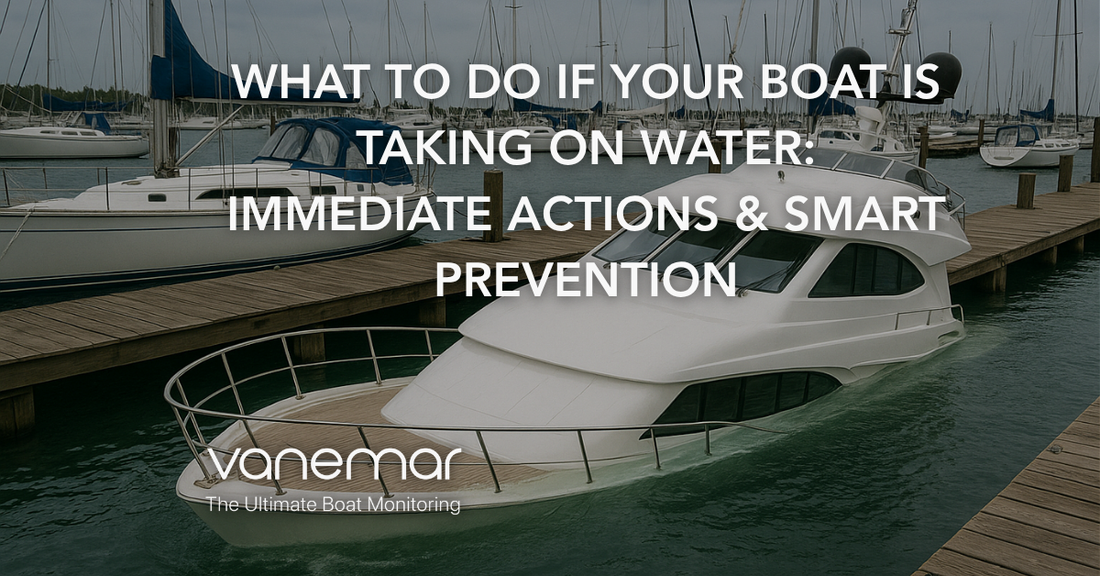
What to Do If Your Boat Is Taking on Water: Immediate Actions and Smart Prevention
Discovering that your boat is taking on water is one of the most stressful moments a skipper can face. Whether you are underway or docked at the marina, acting quickly can make all the difference between a manageable situation and a major emergency.
So, what should you do if you notice water where it shouldn’t be? And how can you prevent this from happening again in the future? Being prepared and knowing how to respond can help you turn a crisis into a controlled situation; keeping both your vessel and your crew safe.
Step 1: Stay Calm and Identify the Source
The first priority is to remain calm and quickly assess the situation. If you are wondering “Why is my boat taking on water, why?”. The answer usually depends on whether the problem starts with the boat’s action. Is the boat taking on water while running or the boat taking on water while sitting? This detail can help narrow down the cause.
Here are the most common reasons boats take on water:
Hull Damage: Cracks, punctures, or worn-out seals may let water in.
Leaking Through-Hull Fittings: Hoses or fittings connected to the hull can fail, especially if seals are old or improperly maintained.
Bilge Pump Issues: A malfunctioning bilge pump may allow water to build up unnoticed.
Weather Conditions: Heavy rain or waves can flood the deck, particularly if scuppers are blocked.
Propeller Shaft or Rudder Post Leaks: These areas are frequent sources of leaks, especially on older boats.
Once you locate the source of the problem, take immediate steps to minimize the flow. If the leak is accessible, use a temporary fix such as:
A soft wooden plug (keeping a few onboard is always a good idea)
Cloth, tape, or a towel as an emergency seal
Vanemar’s real-time bilge monitoring (if installed) to help you keep track of rising water levels remotely in case you need to monitor while troubleshooting
Step 2: Activate Bilge Pumps and Start Bailing
If your bilge pump is functional, immediately turn it on. Make sure it is clear of debris and working at full capacity. Vanemar users can check bilge activity and get automatic high-water alerts directly on their phone via the Vanemar app as a helpful safety net if the issue begins unnoticed.
If the bilge pump is not enough or fails, start manually bailing with buckets, pots, or any container you have on board.
If the situation is getting worse:
Put on life jackets and make sure everyone onboard is ready for evacuation if needed.
Call for assistance using your VHF radio or mobile communication device.
Clearly state your location and explain the situation. Stay on the line if possible.
Step 3: Focus on Safety First
Your priority is always the safety of the people onboard. Boats can be repaired or replaced but lives cannot. Keep everyone informed, calm, and prepared for next steps. If abandoning the vessel becomes necessary, make sure you have grabbed emergency equipment such as:
Life jackets and life rafts
An emergency beacon (EPIRB)
Your phone or handheld VHF radio (preferably waterproof)
Step 4: Take Preventive Measures for the Future
Once the immediate danger has passed, it is time to think about long-term solutions to avoid this problem in the future. Regular maintenance and smart monitoring are key to keeping your boat safe.
Here are some best practices:
Inspect the Hull and Fittings Regularly: Look for cracks, soft spots, or worn-out hardware that could lead to leaks.
Test Bilge Pumps and Alarms: Check automatic switches, clean filters, and ensure your pump can handle water quickly in an emergency.
Install a High-Water Alert System: Vanemar’s Bilge Sensor notifies you the moment your boat’s bilge water reaches a critical level, so you are always informed, even when you are away.
Monitor Battery Health: Bilge pumps depend on battery power. With Vanemar’s Battery Sensor Marine, you will know your boat’s power system is ready to respond when needed.
Practice Emergency Drills: Make sure your crew and passengers know what to do in a water ingress situation.
Peace of Mind Through Preparedness
A boat taking on water is a serious situation but with the right preparation, tools, and quick thinking, it does not have to become a disaster. Routine checks, smart monitoring, and a plan of action ensure you are always ready to respond.
Vanemar makes this process easier with wireless bilge sensors, battery monitoring, and real-time alerts via the Vanemar App, so you can enjoy your time on the water knowing your boat is safer, smarter, and always connected.



